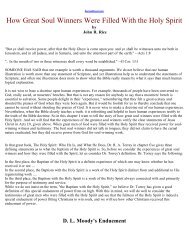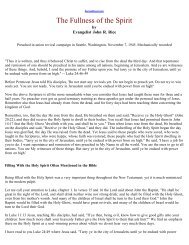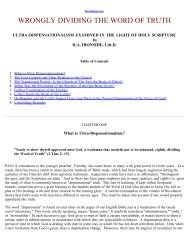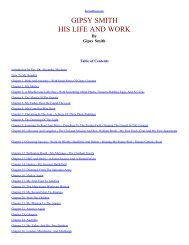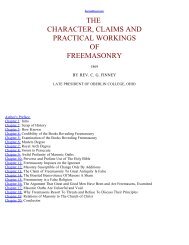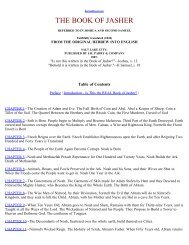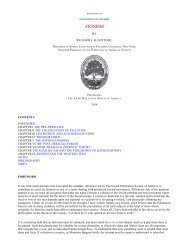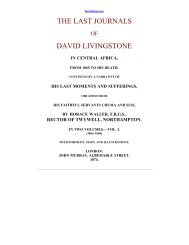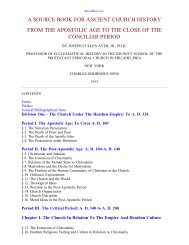Legends of Babylon and Egypt in Relation to Hebrew Tradition.pdf
Legends of Babylon and Egypt in Relation to Hebrew Tradition.pdf
Legends of Babylon and Egypt in Relation to Hebrew Tradition.pdf
You also want an ePaper? Increase the reach of your titles
YUMPU automatically turns print PDFs into web optimized ePapers that Google loves.
L. W. KING.<br />
LECTURE I<br />
EGYPT, BABYLON, AND PALESTINE, AND SOME TRADITIONAL ORIGINS OF CIVILIZATION<br />
At the present moment most <strong>of</strong> us have little time or thought <strong>to</strong> spare for subjects not connected directly or <strong>in</strong>directly<br />
with the war. We have put aside our own <strong>in</strong>terests <strong>and</strong> studies; <strong>and</strong> after the war we shall all have a certa<strong>in</strong> amount <strong>of</strong><br />
leeway <strong>to</strong> make up <strong>in</strong> acqua<strong>in</strong>t<strong>in</strong>g ourselves with what has been go<strong>in</strong>g on <strong>in</strong> countries not yet <strong>in</strong>volved <strong>in</strong> the great<br />
struggle. Meanwhile the most we can do is <strong>to</strong> glance for a moment at any discovery <strong>of</strong> exceptional <strong>in</strong>terest that may<br />
come <strong>to</strong> light.<br />
The ma<strong>in</strong> object <strong>of</strong> these lectures will be <strong>to</strong> exam<strong>in</strong>e certa<strong>in</strong> <strong>Hebrew</strong> traditions <strong>in</strong> the light <strong>of</strong> new evidence which has<br />
been published <strong>in</strong> America s<strong>in</strong>ce the outbreak <strong>of</strong> the war. The evidence is furnished by some literary texts, <strong>in</strong>scribed on<br />
tablets from Nippur, one <strong>of</strong> the oldest <strong>and</strong> most sacred cities <strong>of</strong> <strong>Babylon</strong>ia. They are written <strong>in</strong> Sumerian, the language<br />
spoken by the non-Semitic people whom the Semitic <strong>Babylon</strong>ians conquered <strong>and</strong> displaced; <strong>and</strong> they <strong>in</strong>clude a very<br />
primitive version <strong>of</strong> the Deluge s<strong>to</strong>ry <strong>and</strong> Creation myth, <strong>and</strong> some texts which throw new light on the age <strong>of</strong><br />
<strong>Babylon</strong>ian civilization <strong>and</strong> on the area with<strong>in</strong> which it had its rise. In them we have recovered some <strong>of</strong> the material<br />
from which Berossus derived his dynasty <strong>of</strong> Antediluvian k<strong>in</strong>gs, <strong>and</strong> we are thus enabled <strong>to</strong> test the accuracy <strong>of</strong> the<br />
Greek tradition by that <strong>of</strong> the Sumerians themselves. So far then as <strong>Babylon</strong>ia is concerned, these documents will<br />
necessitate a re-exam<strong>in</strong>ation <strong>of</strong> more than one problem.<br />
The myths <strong>and</strong> legends <strong>of</strong> ancient <strong>Egypt</strong> are also <strong>to</strong> some extent <strong>in</strong>volved. The trend <strong>of</strong> much recent anthropological<br />
research has been <strong>in</strong> the direction <strong>of</strong> seek<strong>in</strong>g a s<strong>in</strong>gle place <strong>of</strong> orig<strong>in</strong> for similar beliefs <strong>and</strong> practices, at least among<br />
races which were bound <strong>to</strong> one another by political or commercial ties. And we shall have occasion <strong>to</strong> test, by means<br />
<strong>of</strong> our new data, a recent theory <strong>of</strong> <strong>Egypt</strong>ian <strong>in</strong>fluence. The Nile Valley was, <strong>of</strong> course, one the great centres from<br />
which civilization radiated throughout the ancient East; <strong>and</strong>, even when direct contact is unproved, <strong>Egypt</strong>ian literature<br />
may furnish <strong>in</strong>structive parallels <strong>and</strong> contrasts <strong>in</strong> any study <strong>of</strong> Western Asiatic mythology. Moreover, by a strange<br />
co<strong>in</strong>cidence, there has also been published <strong>in</strong> <strong>Egypt</strong> s<strong>in</strong>ce the beg<strong>in</strong>n<strong>in</strong>g <strong>of</strong> the war a record referr<strong>in</strong>g <strong>to</strong> the reigns <strong>of</strong><br />
predynastic rulers <strong>in</strong> the Nile Valley. This, like some <strong>of</strong> the Nippur texts, takes us back <strong>to</strong> that dim period before the<br />
dawn <strong>of</strong> actual his<strong>to</strong>ry, <strong>and</strong>, though the <strong>in</strong>formation it affords is not detailed like theirs, it provides fresh confirmation<br />
<strong>of</strong> the general accuracy <strong>of</strong> Manetho's sources, <strong>and</strong> suggests some <strong>in</strong>terest<strong>in</strong>g po<strong>in</strong>ts for comparison.<br />
But the people with whose traditions we are ultimately concerned are the <strong>Hebrew</strong>s. In the first series <strong>of</strong> Schweich<br />
Lectures, delivered <strong>in</strong> the year 1908, the late Canon Driver showed how the literature <strong>of</strong> Assyria <strong>and</strong> <strong>Babylon</strong> had<br />
thrown light upon <strong>Hebrew</strong> traditions concern<strong>in</strong>g the orig<strong>in</strong> <strong>and</strong> early his<strong>to</strong>ry <strong>of</strong> the world. The majority <strong>of</strong> the<br />
cuneiform documents, on which he based his comparison, date from a period no earlier than the seventh century B.C.,<br />
<strong>and</strong> yet it was clear that the texts themselves, <strong>in</strong> some form or other, must have descended from a remote antiquity. He<br />
concluded his brief reference <strong>to</strong> the Creation <strong>and</strong> Deluge Tablets with these words: "The <strong>Babylon</strong>ian narratives are<br />
both polytheistic, while the correspond<strong>in</strong>g biblical narratives (Gen. i <strong>and</strong> vi-xi) are made the vehicle <strong>of</strong> a pure <strong>and</strong><br />
exalted monotheism; but <strong>in</strong> spite <strong>of</strong> this fundamental difference, <strong>and</strong> also variations <strong>in</strong> detail, the resemblances are<br />
such as <strong>to</strong> leave no doubt that the <strong>Hebrew</strong> cosmogony <strong>and</strong> the <strong>Hebrew</strong> s<strong>to</strong>ry <strong>of</strong> the Deluge are both derived ultimately<br />
from the same orig<strong>in</strong>al as the <strong>Babylon</strong>ian narratives, only transformed by the magic <strong>to</strong>uch <strong>of</strong> Israel's religion, <strong>and</strong><br />
<strong>in</strong>fused by it with a new spirit."[1] Among the recently published documents from Nippur we have at last recovered<br />
one at least <strong>of</strong> those primitive orig<strong>in</strong>als from which the <strong>Babylon</strong>ian accounts were derived, while others prove the<br />
existence <strong>of</strong> variant s<strong>to</strong>ries <strong>of</strong> the world's orig<strong>in</strong> <strong>and</strong> early his<strong>to</strong>ry which have not survived <strong>in</strong> the later cuneiform texts.<br />
In some <strong>of</strong> these early Sumerian records we may trace a fa<strong>in</strong>t but remarkable parallel with the <strong>Hebrew</strong> traditions <strong>of</strong><br />
man's his<strong>to</strong>ry between his Creation <strong>and</strong> the Flood. It will be our task, then, <strong>to</strong> exam<strong>in</strong>e the relations which the <strong>Hebrew</strong><br />
narratives bear both <strong>to</strong> the early Sumerian <strong>and</strong> <strong>to</strong> the later <strong>Babylon</strong>ian Versions, <strong>and</strong> <strong>to</strong> ascerta<strong>in</strong> how far the new<br />
discoveries support or modify current views with regard <strong>to</strong> the contents <strong>of</strong> those early chapters <strong>of</strong> Genesis.



